Solving Nuclear Storage Issues with Powder Alloys
White Papers
Seen as a solution to storing spent nuclear fuel rods, alternative powder alloys provide shielding for thermal neutron radiation. The desire to meet the requirements of an increasingly energy-hungry world without the carbon emissions associated with fossil-fuel-fired power plants has caused many utility companies to consider nuclear energy.
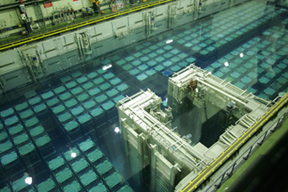
Spent fuel rods cooling in a wet storage tank at a nuclear power plant
According to the World Nuclear Association, as of October 2011 there are 432 commercial nuclear reactors operating worldwide with an additional 63 reactors under construction. Another 152 reactors are on order or planned with an additional 350 nuclear reactors proposed for construction. These 502 additional nuclear reactors are expected to be operational by 2030.
Depending on the nuclear reactor design, removal of a quarter to a third of the nuclear fuel rods in the reactor is approximately every 12 to 24 months. These spent nuclear fuel rods are normally placed into a temporary on-site storage facility where the spent fuel rods are cooled for at least a year and typically several years. The spent fuel rods are kept in wet storage pools until they are sufficiently cooled to permit them to be transferred to alternative dry intermediate storage or reprocessing sites.
Many nuclear power plants have used specially designed storage racks and containers or casks made from boron-containing stainless steel as a shielding material to control the flow of thermal neutrons in the spent nuclear fuel bundles, or rods. These racks or casks are designed to hold 40 to 60 rods.
Borated stainless steels have a stable micro-structure and mechanical properties under exposure to long-term thermal neutron irradiation. The boron contained in borated stainless steels is usually natural boron, which contains two isotopes, nominally 18.4wt% 10B, a boron isotope that absorbs thermal neutrons, and nominally 81.6wt% 11B, a boron isotope that does not absorb neutrons.
Borated stainless steels – including those produced by traditional cast/wrought methods and those made by pre-alloyed powder metallurgy techniques – have also been used for the over-the-road dry transportation casks. These casks are for transferring spent fuel from a wet or dry storage facility to another more permanent location, such as a monitored retrievable storage (MRS) regional site, a permanent repository. One such permanent repository is the proposed Yucca Mountain site in Nevada.
Some spent nuclear storage rack system producers have found that the use of conventional borated stainless steels necessitated a long, complicated manufacturing process to make their products have been considering certain alternative materials. Included in these alternatives are powder metal alloys such as Micro-Melt® NeutroSorb® alloys produced by the Carpenter Powder Products division of Carpenter Technology Corp., Wyomissing, PA. The reasoning is that Micro-Melt NeutroSorb alloys are considerably more ductile than conventionally cast borated stainless ingot.
Not only could Micro-Melt NeutroSorb alloys be easier for them to use, but it could also be a more economical solution for the manufacture of spent nuclear storage rack systems and certain other nuclear power plant applications.
Micro-Melt NeutroSorb alloys are a family of high boron specialty stainless steel produced using pre-alloyed, gas atomized powder metallurgy technology. It is similar to conventional Type 304 stainless steel except for its boron addition, which imparts a much higher thermal neutron absorption cross section than standard austenitic stainless steels. In addition to being used for spent fuel rod storage racks, it has also been used in the nuclear industry for burnable poison rods and shielding.
Micro-Melt NeutroSorb borated stainless is produced by hot isostatically pressing gas atomized pre-alloyed powder to 100% density followed by hot and cold working to produce finished plate, sheet, and strip products. This process produces a uniform distribution of small boride particles throughout the finished product. Conventionally produced cast/wrought borated stainless steel products, usually made by air melting and refining followed by casting into ingots and hot and cold working, contain much larger and significantly less uniformly distributed particles.
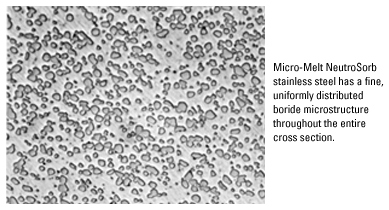
The fine, uniform boride distribution in Micro-Melt NeutroSorb alloys also results in improved mechanical properties compared to cast/wrought borated stainless products. Micro-Melt NeutroSorb alloy products are also easier to fabricate than conventional borated stainless steel with equivalent boron content, promoting higher processing yields for customers.
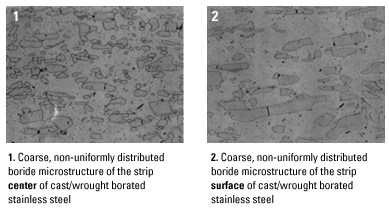
Powder metallurgy processing also allows for the addition of more boron, which, in turn, increases the thermal neutron absorption capability of the alloy. Micro-Melt NeutroSorb alloys can contain boron levels of up to 2.25%, although boron concentrations up to 2.75% are possible if reduced ductility is acceptable. By comparison, conventionally produced borated stainless alloys seldom contain boron levels greater than 1.2%.
Increasing boron content increases hardness, tensile strength, and yield strength while decreasing tensile ductility, impact toughness, and corrosion resistance. However, through controlled special processing, Micro-Melt NeutroSorb alloys, which are normally manufactured to the ASTM A 887 specification, have less of a decrease in ductility and impact toughness as the boron content increases compared with similar boron-containing cast/wrought, boron-containing cast/wrought borated stainless steels.
Since the amount of thermal neutron absorption is a function of the amount of boron contained in the material composition and its thickness, storage racks using Micro-Melt NeutroSorb alloys can be made with thinner gauge sections, allowing the racks to have a smaller overall footprint and/or store more spent nuclear fuel rods.
The boron addition in Micro-Melt NeutroSorb alloys can consist of natural boron and/or the enriched 10B isotope, which offers a higher neutron absorption cross section for a given total boron content. 10B isotope enrichment also enables use of less total boron for equivalent neutron absorption, providing improved ductility and impact toughness.
Powder metallurgy NeutroSorb alloys also possess corrosion resistance characteristics approaching that of Type 304 stainless. While the addition of boron to a Type 304 stainless steel tends to reduce the corrosion resistance in some acidic environments, no significant corrosion has been reported with Micro-Melt NeutroSorb alloys in spent fuel storage applications. In fact, laboratory testing has shown that it exhibits considerably less corrosion resistance reduction than conventionally produced borated stainless steels.
Carpenter has already received a major order for Micro-Melt NeutroSorb alloy strip from one spent fuel storage rack producer and is currently in negotiations with companies in France, Germany, Sweden, and other countries around the world to have them use Micro-Melt NeutroSorb alloys for their racks as well. Currently only a few commercial American utility companies use borated stainless steels in their wet fuel storage pools to store the spent fuel rods from their nuclear power plants, opting instead for sandwich or composite materials.
Carpenter is also manufacturing a large quantity of Micro-Melt NeutroSorb alloy plate for the French-based International Thermonuclear Experimental Reactor (ITER) project. The material is used as inner wall thermal neutron shielding for a prototype nuclear fusion reactor, which the group hopes to have ready for operation by 2026. Formed in 2005, the ITER consortium is comprised of researchers from the European Union, Japan, South Korea, China, Russia, India, and the United States, who have joined forces to test the concept of producing energy on a large scale through nuclear fusion. It requires the use of many specialty metals such as Micro-Melt NeutroSorb stainless alloys.
Building upon the advances it has already achieved with its Micro-Melt NeutroSorb family of alloys, Carpenter has recently developed a new family of powder metallurgy based, stainless steel alloys having an improved thermal neutron absorption capability up to nominally six times that of existing borated stainless steels. These new alloys also have improved mechanical and corrosion properties compared with both Micro-Melt NeutroSorb alloys and conventionally produced borated stainless steels. Carpenter has filed patent applications for this new family of thermal neutron absorption alloys.
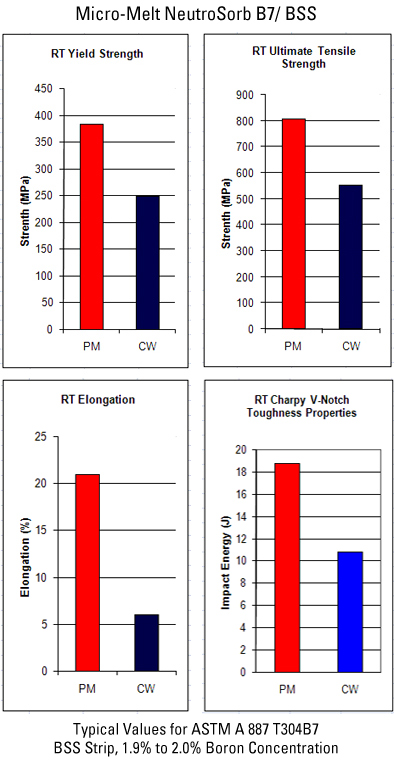
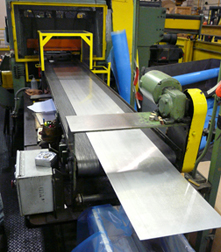
Micro-Melt NeutroSorb strip could be fabricated into spent fuel rod storage racks as well as other products.
***
By Lou Lherbier, Director of Technical Market Development, Carpenter Technology Corp.
Greg Del Corso, Manager of Powder Products R&D, Carpenter Powder Products